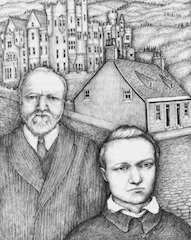|
J. William T. "Bill" Youngs, American Realities, Volume Two:
Historical Episodes from Reconstruction to the Present, Chapter Three |
Ohio Works of the Carnegie Steel Co., courtesy of the Library of Congress
|
3. The New Industrial Era
|
SummaryIn three centuries, the character of American life has undergone several dramatic changes. In the colonial period, Euro-Americans replaced Indians as the dominant population on the eastern seaboard. During the Revolution, thirteen British colonies formed an independent nation. Early in the nineteenth century, a coastal people spread westward to the Mississippi. And after the Civil War, four million slaves were freed from bondage. Each of these epochal events affected the American environment, but no change was more influential than industrialization in the late nineteenth century. The growth of big business affected where Americans lived, what they consumed, how they worked, and what they thought. If Rip Van Winkle had slept from 1870 to 1910, he would have seen changes far greater than those wrought by the American Revolution. The men who had led the industrial movement, entrepreneurs like Andrew Carnegie, were the most influential people of their time. Their histories reveal the massiveness of the new enterprises and suggest that even the captains of industry had trouble adjusting to their own unprecedented power.
|
Author reads from the Text
The philosophical basis of Carnegie’s optimism was Social Darwinism. After Charles Darwin’s On the Origin of Species was published in 1859, many businessmen applied a simplified version of Darwin’s ideas to human society: the “survival of the fittest” would lead to higher and higher forms of civilization. Social Darwinism naturally appealed to successful businessmen who wanted to believe that their achievements were attributable to their own “fitness” and contributed to the elevation of all mankind. The man most associated with this idea was Herbert Spencer, an English philosopher, whose works Andrew Carnegie claimed to treasure above all others. Carnegie said that upon reading Spencer, “Light came in as a flood and all was clear.” Spencer showed him that “Man was not created with an instinct for his own degradation, but from the lower he had risen to the higher forms. Nor is there any conceivable end to his march to perfection. His face is turned to the light, he stands in the sun and looks upward.” In material achievement there can be no doubt that Carnegie contributed greatly to America’s “march to perfection.” America needed steel for buildings, ships, bridges, railroads—for the very sinews of the new industrial age—and Carnegie supplied it.

